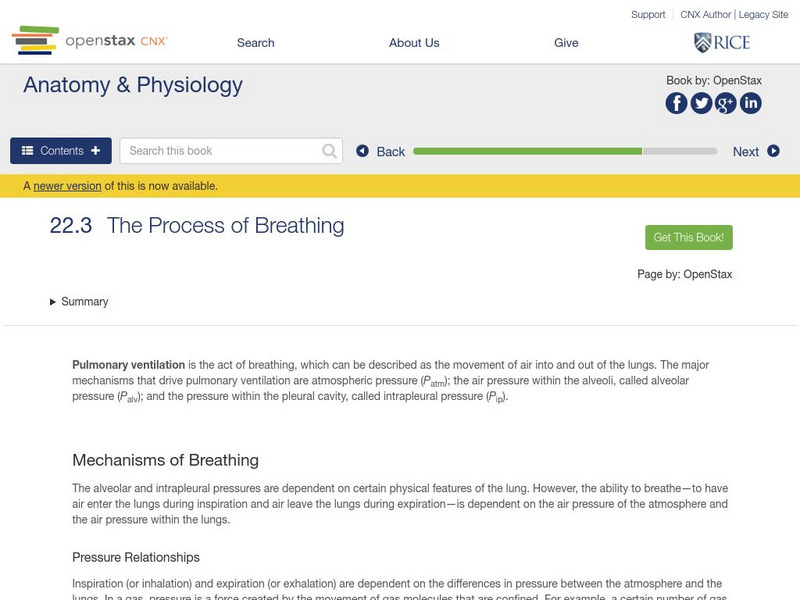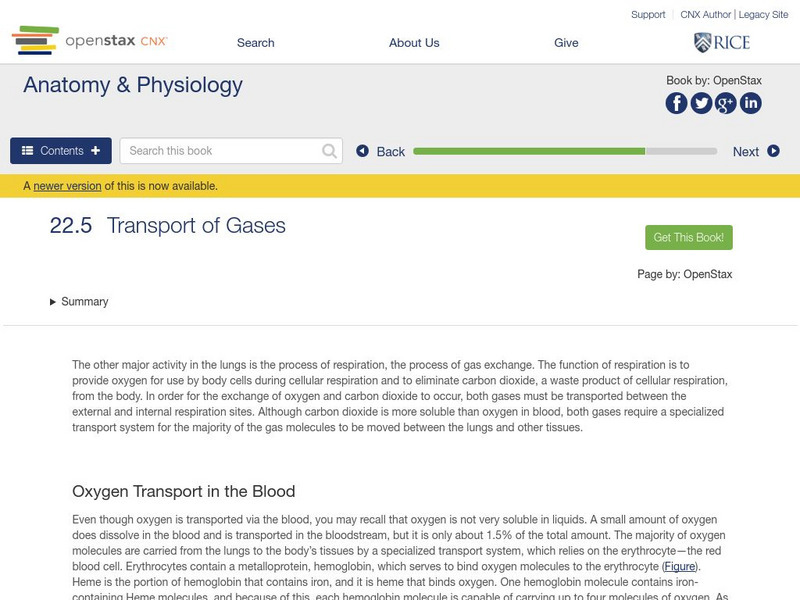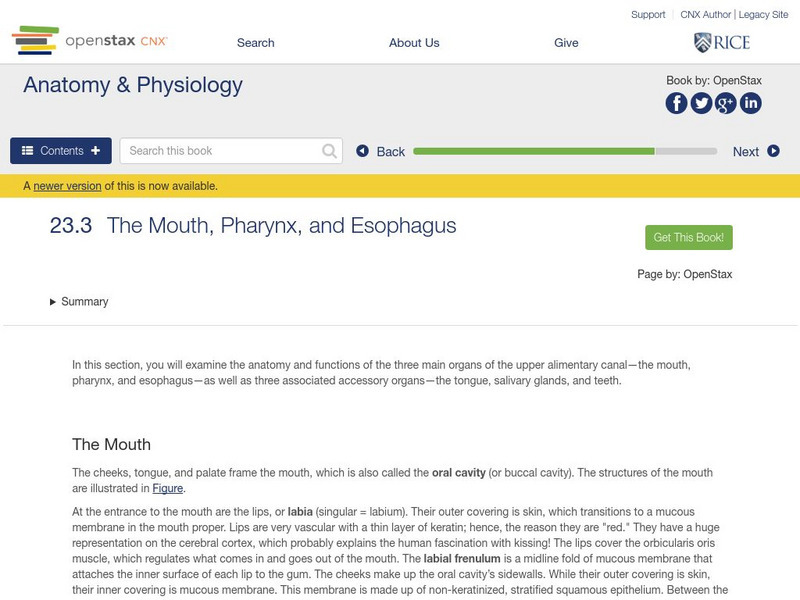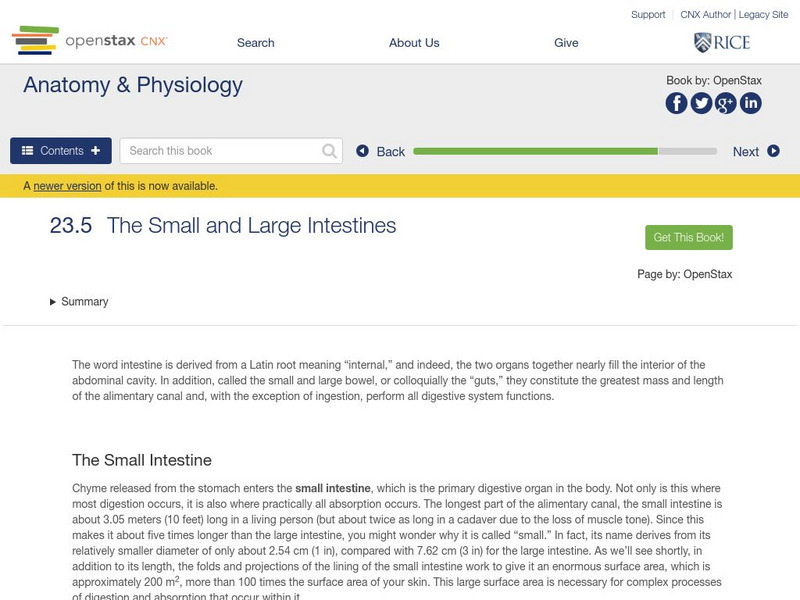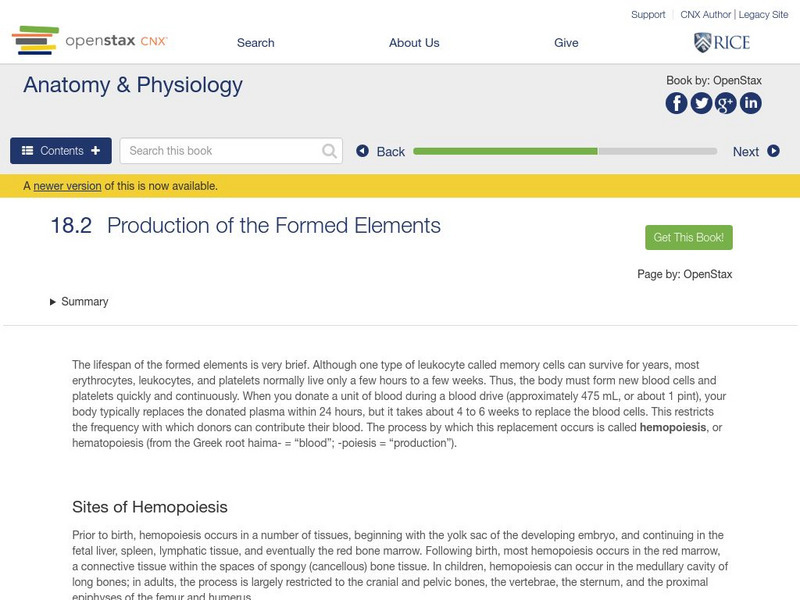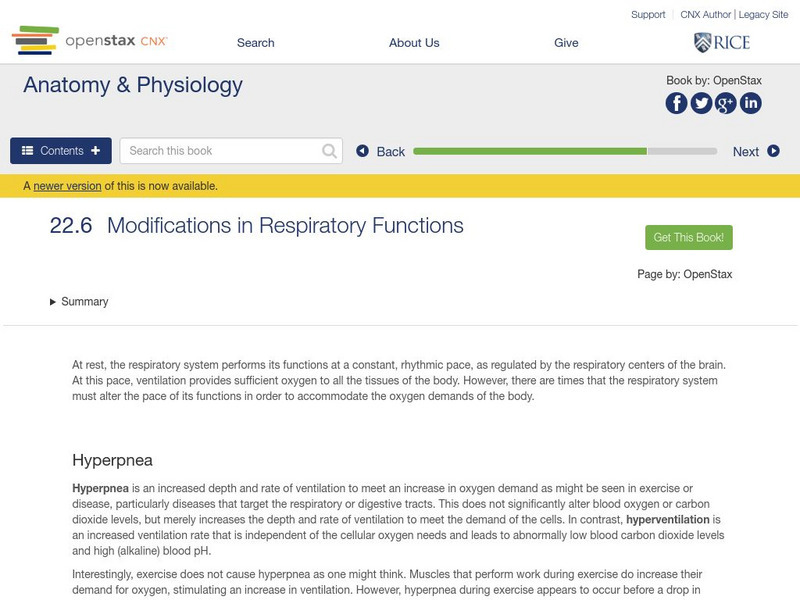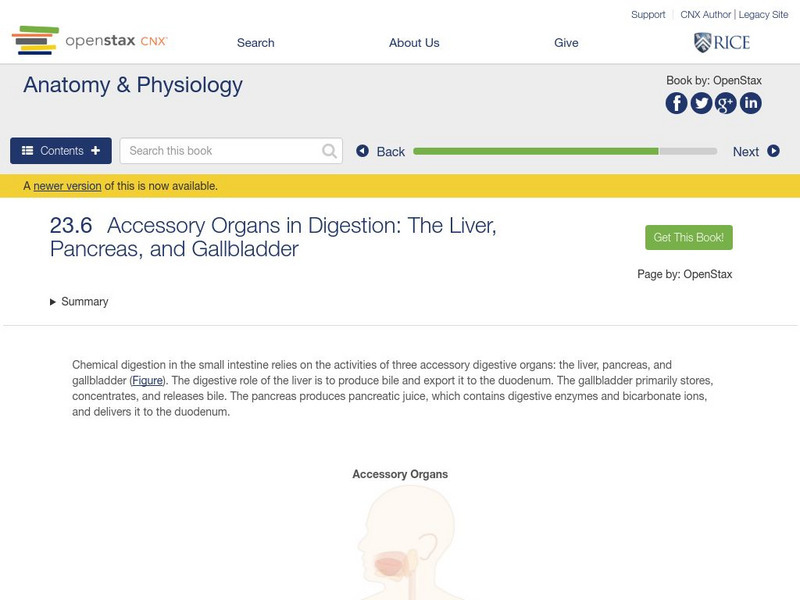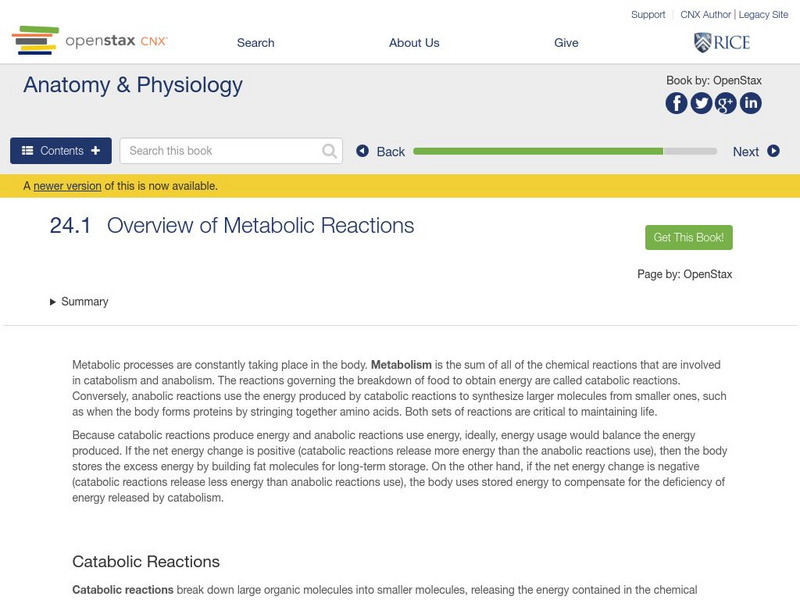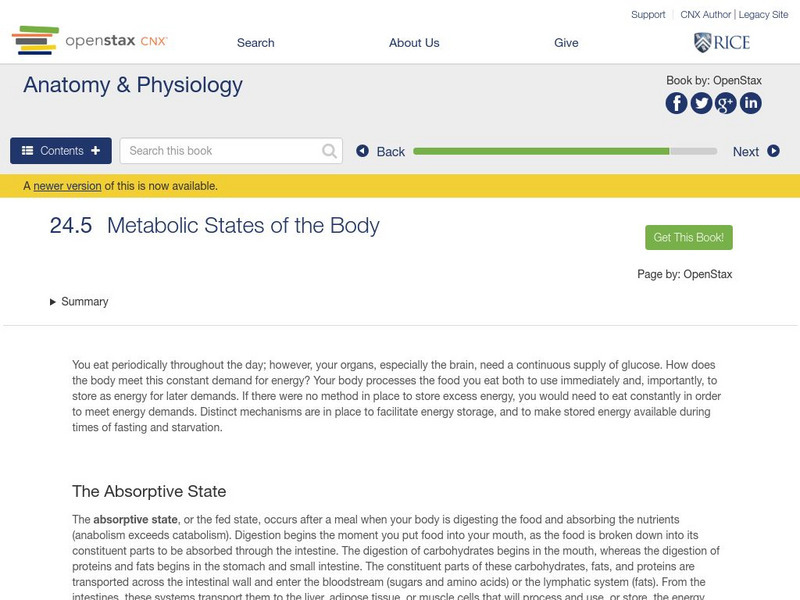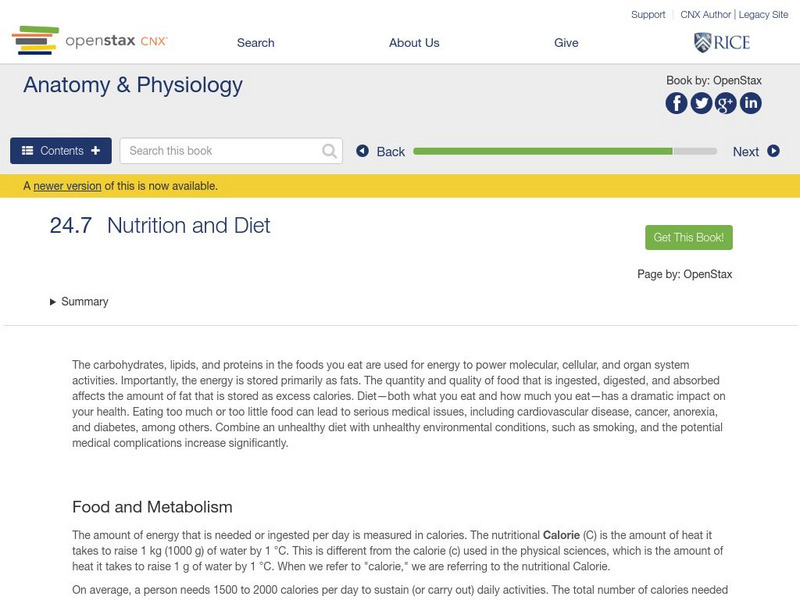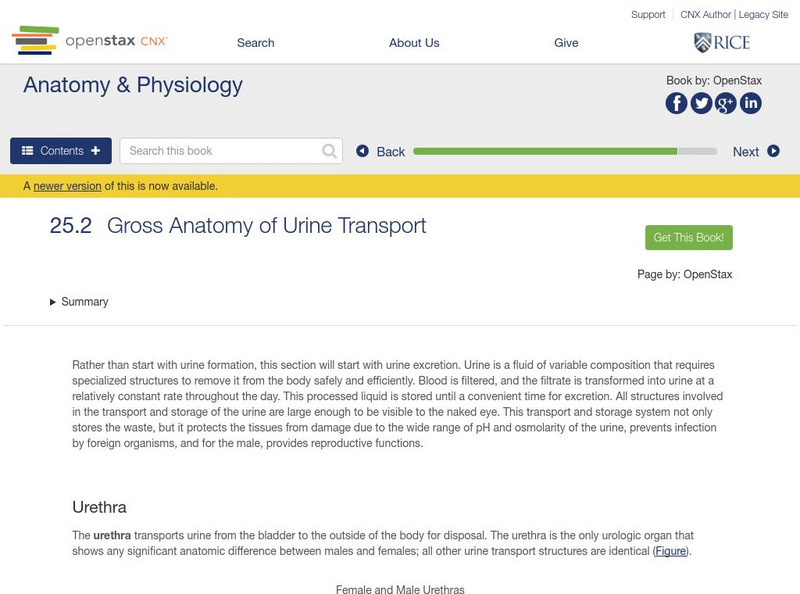OpenStax
Open Stax: Anatomy & Physiology: The Process of Breathing
Find out about the breathing process by understanding the mechanisms that drive breathing and the steps involved in pulmonary ventilation.
OpenStax
Open Stax: Anatomy & Physiology: Transport of Gases
Students learn the principles of oxygen and carbon dioxide transport within the human body, and understand the structure of hemoglobin.
OpenStax
Open Stax: Anatomy & Physiology: The Mouth, Pharynx, and Esophagus
Describe the structures of the mouth, including its three accessory digestive organs: the mouth, pharynx, and esophagus. Also trace the pathway food follows from ingestion into the mouth through release into the stomach.
OpenStax
Open Stax: Anatomy & Physiology: The Stomach
Students learn about the mechanical and chemical digestion of food entering the stomach as well as many other functions of the stomach which aid in digestion.
OpenStax
Open Stax: Anatomy & Physiology: The Small and Large Intestines
With this module, students will be able to identify three main adaptations of the small intestine's wall that increase its absorptive capacity. Students will also trace the pathway of food waste from its point of entry into the large...
OpenStax
Open Stax: Anatomy & Physiology: Regulation of Renal Blood Flow
Students learn about the myogenic and tubuloglomerular feedback mechanisms, and explain how they affect urine volume and composition.
OpenStax
Open Stax: Anatomy & Physiology: Production of the Formed Elements
Students trace the generation of the formed elements of blood from bone marrow stem cells, and then learn the role of hemopoietic growth factors in promoting the production of the formed elements.
OpenStax
Open Stax: Anatomy & Physiology: Hemostasis
Students learn about hemostasis through online text readings, illustrated diagrams, interactive link questions, and self-checking practice questions.
OpenStax
Open Stax: Anatomy & Physiology: Heart Anatomy
Students learn the anatomy and physiology of the human heart through text readings, illustrated diagrams, and self-checking review questions at the end.
OpenStax
Open Stax: Anatomy & Physiology: Gas Exchange
Students learn the steps of the gas exchange process that takes place during human respiration.
OpenStax
Open Stax: Anatomy & Physiology: Modifications in Respiratory Functions
Students learn how the human respiratory system undergoes modifications when the conditions change. Included are the processes of hyperpnea, hyperventilation, and acclimatization.
OpenStax
Open Stax: Anatomy & Physiology: Overview of the Digestive System
Students learn about the structure and function of the human digestive system, the accessory digestive organs, the tissue layers of the alimentary canal, the contributions of the enteric and autonomic nervous systems to digestive system...
OpenStax
Open Stax: Anatomy & Physiology: Liver, Pancreas, Gallbladder
Students learn about the main digestive roles of the liver, pancreas, and gallbladder, and identify three main features of liver histology that are critical to its function.
OpenStax
Open Stax: Anatomy & Physiology: Overview of Metabolic Reactions
Students discuss the role of polymers, monomers, and ATP in metabolism, and then describe the hormones that regulate anabolic and catabolic reactions.
OpenStax
Open Stax: Anatomy & Physiology: Lipid Metabolism
Students learn how energy can be derived from fat, and then explain the purpose and process of ketogenesis, ketone body oxidation, and lipogenesis.
OpenStax
Open Stax: Anatomy & Physiology: Protein Metabolism
Students will learn how the body digests proteins, and will explain how protein can be used for energy.
OpenStax
Open Stax: Anatomy & Physiology: Metabolic States of the Body
Students describe what defines each of the three metabolic states of the human body: the absorptive state, the postabsorptive state, and starvation.
OpenStax
Open Stax: Anatomy & Physiology: Nutrition and Diet
Explain how different foods and eating a healthy diet can affect a person's metabolism. Also learn reasons why vitamins and minerals are critical to a healthy diet.
OpenStax
Open Stax: Anatomy & Physiology: Physical Characteristics of Urine
Students learn the chemical make-up and pH of urine in the human body.
OpenStax
Open Stax: Anatomy & Physiology: Gross Anatomy of Urine Transport
Students learn about the location, structure, histology, and function of the tissues involved in urine transport and excretion including the ureters, urinary bladder, and urethra.
OpenStax
Open Stax: Anatomy & Physiology: Gross Anatomy of the Kidney
Students learn about the external structure of the kidney, including its location, support structures, and covering, as well as the major internal divisions and structures of the kidney.
OpenStax
Open Stax: Anatomy & Physiology: Microscopic Anatomy of the Kidney
Students learn about the renal structures that conduct the essential work of the kidneys and cannot be seen by the naked eye.
OpenStax
Open Stax: Anatomy & Physiology: Physiology of Urine Formation
Focus on the physiology of the urinary system, and discover that different parts of the nephron utilize specific processes to produce urine: filtration, reabsorption, and secretion. Learn how each of these processes works and where they...
OpenStax
Open Stax: Anatomy & Physiology: Maternal Changes During Pregnancy and Birth
Students learn about the changes that happen in a woman's body during pregnancy, labor, and delivery of a baby.


